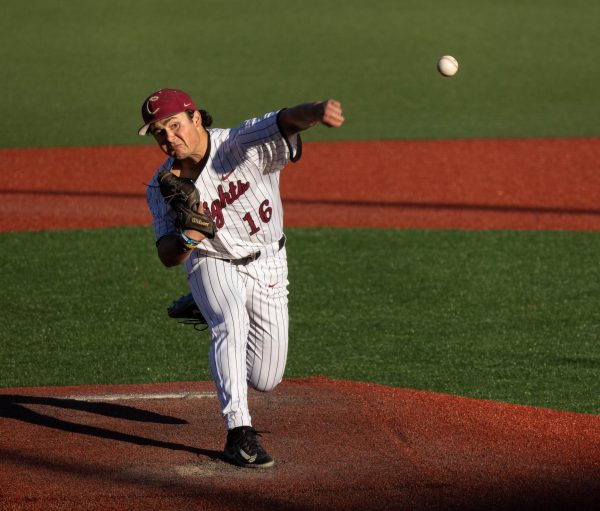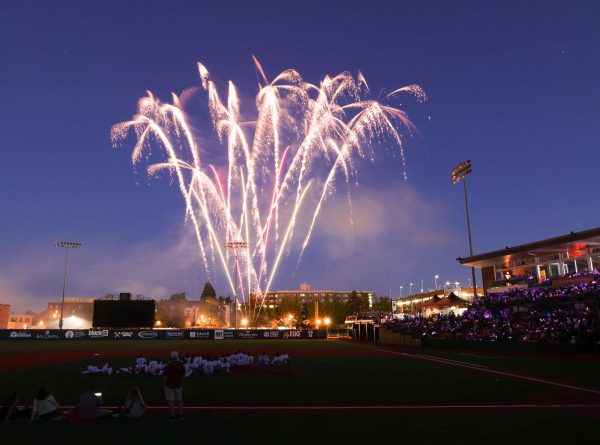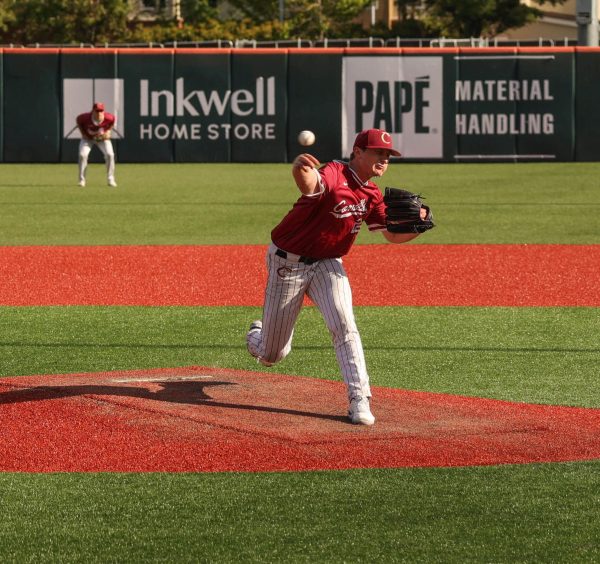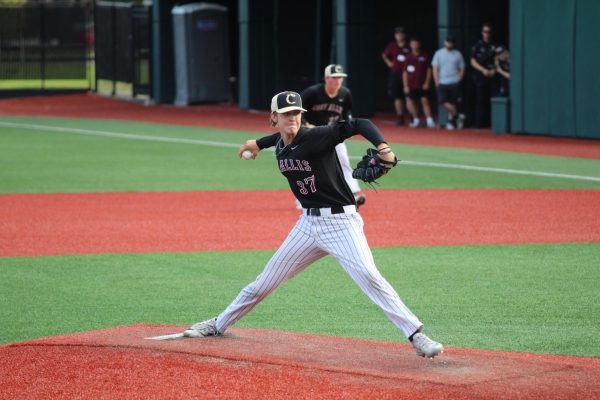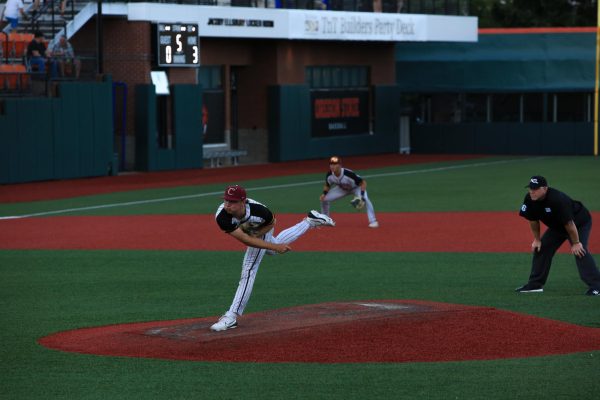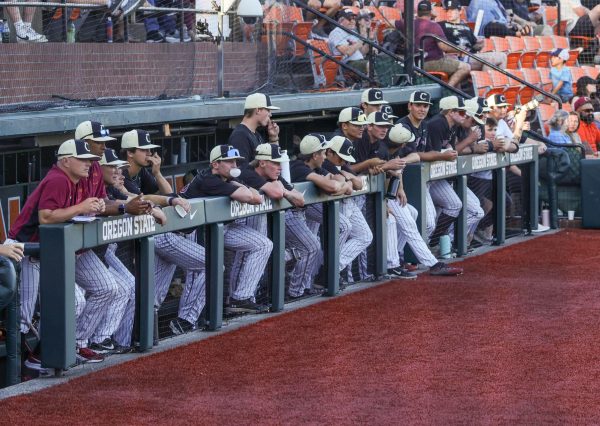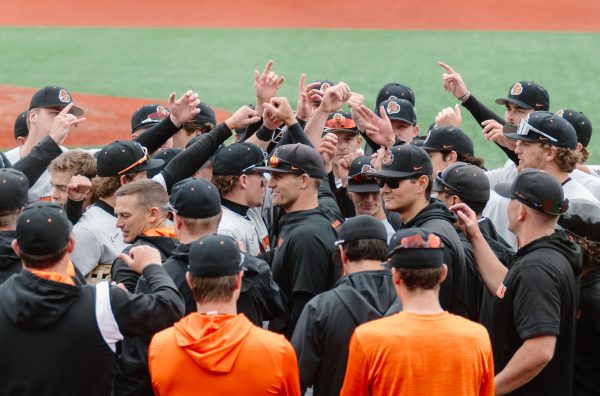Sports Breakdown: Baseball and Softball
June 9, 2020
Baseball and softball are bat-and-ball games played between two opposing teams who take turns between batting and fielding.
While both sports are enjoyed worldwide, they are most popular in the United States, Japan, and Latin America. In the U.S., baseball is one of the most popular sports for both participants and spectators and is often referred to as “the national pastime.”
Major League Baseball is the premiere baseball organization in North America and consists of two 15-team leagues, the National League (N.L.) and American League (A.L.). The champions of these two leagues meet every fall in the World Series, a best-of-seven championship series that determines that season’s overall champion. Additionally, there are over 250 Minor League teams nationwide, and thousands of amateur, collegiate, and club teams across the nation.
While professional softball has not enjoyed the commercial success that baseball has, the game is very popular at the high school and collegiate levels. Additionally, softball is an incredibly popular recreational activity for adults. Millions of men and women of all ages play the game every year. Softball teams and leagues of all levels of skill are commonplace nationwide, making the game widely accessible for even the most novice of players.
The rules for both games are fairly simple. Two teams play each other for a specified amount of periods, called innings. Most baseball games are nine innings long, while softball games are usually seven innings long. Each inning is split into two halves, the top and bottom. The visiting team generally bats at the top of the inning, while the home team bats at the bottom. This gives the home team a slight advantage as they will always be the last team to have an opportunity to score.
Both sport’s fields are shaped like a diamond, with all four bases at an equal distance apart from each other. Points, called runs, are scored each time a player safely makes their way counterclockwise around all four bases. Players can run from base to base when the ball is in play.
Each team will bat at least three times during an inning. When a player steps into the batting box, their goal is to hit a ball thrown to them by the opposing team’s pitcher and safely reach a base.
If a batter swings at a ball but fails to hit it, they are given a “strike.” If a batter records three strikes, they are “out” and have to sit in their team’s dugout until the remaining eight batters on the team take their turn. Each team gets three outs per inning. When three outs are recorded, the teams change positions, with players from the batting team moving to the field and players from the fielding team individually stepping up to the plate.
If a batter hits a ball and it lands in an area outside of the field of play, they are given a “foul.” The first two fouls a batter hits count as strikes. However, all fouls after strike two do not count as strikes and the swing count remains the same, giving the player another opportunity to hit the ball into play.
If a batter hits a ball into fair territory and an opposing fielder catches it before it touches the ground, that batter is automatically out. However, if the ball hits the ground first before a fielder catches the ball, the batter, who now has become a runner, will need to run to the next base before a fielder can tag them with it. As long as the runner touches the base before the fielder at that base catches the ball or tags them with it, they are considered “safe.”
For pitchers, the goal is to allow as few batters to get on base as possible. Because of this, pitchers will throw different styles of pitches in an attempt to confuse batters. These pitches may change in speed, direction, or angle before reaching the batter, all in an attempt to earn a strike.
Pitches that are not swung at outside of the “strike zone” are considered “balls.” The strike zone is the space between the batter’s knees and the midpoint of their torso. If a batter receives four balls, they are given a “walk” and are automatically placed on first base
Whichever team has the most runs at the end of regulation play is declared the winner of the game. If the score is tied after regulation, the game goes into “extra innings” and continues until one team is ahead at the completion of an inning.
What are the differences between baseball and softball?
While both games are similar, there are some notable differences between baseball and softball.
Balls: In baseball, the balls are white with red stitching and have a circumference of 9 inches. In softball, the balls are yellow with red stitching and have a circumference of 12 inches. Softballs are also made of lighter materials, hence their name.
Bats: Although the bats used in both sports appear similar, baseball bats are generally longer, have a greater diameter and heavier than those used in softball. Metal bats are common at the amateur and collegiate level in both sports, while wood bats are required in most professional baseball leagues.
Field Size: While the size of fields varies in both sports depending on the level of play, baseball fields are almost always larger than softball fields. The bases of a softball field are 60 feet apart, whereas they are 90 feet apart on a baseball field. Outfields are also smaller in softball, with the average furthest point from home plate in softball being 220 feet away. In baseball, that point can be 400 or more feet away.
Pitcher’s Mound Vs. Circle: A major difference between both sports is the area in which the pitcher stands. In baseball, the pitcher stands on a dirt mound with a rubber that is 10 inches above the ground. These mounds are 60 feet and 6 inches away from home paint. In softball, the pitcher stands in a flat circle, usually marked with chalk, with a rubber that is 43 feet away from the plate.
Pitching Style: Pitching is the most obvious difference between both sports. In softball, the ball has to be thrown underhand, whereas in baseball the ball is almost always thrown overhand.
Glossary
Ace: A team’s best pitcher, generally the first in their starting rotation.
Backstop: The fence or barrier behind the home plate. Designed to protect spectators from wild pitches or balls.
Ball: A pitch that misses the strike zone and is not swung at by the batter.
Base: One of four points a player must run through to score a run. Sometimes referred to as a bag.
Bat: A smooth rounded metal or wooden rod used to hit the ball thrown by the pitcher.
Batter: Offensive player in the batting box who will attempt to hit the ball. Also referred to as a hitter.
Batter’s Box: A rectangular area on either side of home plate in which the batter must stand for play to resume.
Bullpen: Area where pitchers and catchers warm-up before play. Relief pitchers also sit here while not in play. Depending on the ballpark, this area can be to the side of the field on the left or right baseline, or behind the outfield fence.
Bunt: When a batter loosely holds the bat across home plate and intentionally taps the ball softly into the infield. Typically a player will perform a sacrifice bunt to allow other runners to advance bases.
Can of Corn: An easy-to-catch outfield hit.
Catcher: A player who crouches behind home plate and catches balls not hit by the batter.
Caught Looking: A third strike is called on a batter who did not take a swing.
Change Up: A slow pitch that is thrown in a way to deceive the batter into believing it is a fastball.
Cleanup Hitter: The fourth batter in the lineup, usually a power hitter.
Closer: A relief pitcher who finishes the game.
Clubhouse: A team’s locker room.
Complete Game: When a single pitcher pitches an entire game without the help of a relief pitcher.
Count: The number of balls and strikes a batter has in their current at-bat. For example, a batter with a 3-2 count, known as a full count, has three balls and two strikes.
Curveball: A pitch that breaks to the left or right of the home plate right before reaching the strike zone.
Designated Hitter (baseball): A non-field player who bats in place of the pitcher.
Designated Player (softball): A non-field player who bats in place of any fielder.
Double: A two-base hit.
Double Header: When a team plays two consecutive games in a row.
Double Play: A defensive play that results in two outs.
Dugout: The area where players and other on-field officials sit while not in play.
Ejection: When a player or member of the coaching staff is removed from the game by an umpire for unsportsmanlike conduct.
Error: A mistake made by a defensive player that allows a batter or baserunner to reach one or more additional bases.
Extra Innings: Additional innings added to the game if the score remains tied following the end of regulation play.
Fair Territory: The area that is within playing boundaries. Fair Territory is marked by painted lines on the field and foul poles on the right and left field sides.
Fastball: A ball that is pitched straight and fast.
Fly Ball: A ball hit high in the air.
Flyout: A fly ball caught by a defensive player before hitting the ground, resulting in the batter being automatically out.
Force Out: An out in which a runner is forced to the next base because there is another runner behind him/her.
Foul Ball: A ball that has gone out of fair territory.
Gap: The area between the outfielders. Also referred to as an alley.
Hit: When a batter successfully reaches a base after batting the ball into fair territory.
Home Run: When a runner is able to score a run by passing through all four bases without stopping or being declared out. Balls hit over the outfield fence in fair territory are automatically home runs.
Infield: The area of the field boarded by the three bases and home plate. The first baseman, second baseman, third baseman, and shortstop all play in the infield.
Inning: A period of play consisting of two halves. Baseball usually has nine innings, while softball generally has seven.
Lineup: The order in which each player on a team will go to bat.
Manager: The head coach of a team.
No-hitter: A game where a team records no hits. Sometimes referred to as a “no-no.”
Out: When a batter or runner for whatever reason cannot advance to the next base.
Outfield: The area of the field that is outside of the four-base diamond. Three defensive players patrol the outfield (Left Field, Center Field, Right Field).
Passed Ball: A pitched ball escapes the catcher, allowing for runners to advance to the next base.
Perfect Game: When a pitcher prevents every batter from reaching first base. This is a rare feat, as there have only been 23 perfect games in MLB history.
Pickoff: When a batter quickly throws the ball to a fielder covering a base, who in return attempts to tag an unsuspecting runner out.
Pitch: The delivery of the baseball to the batter.
Pitcher: A fielder who throws the ball to batters.
Pitcher’s Circle (softball): A flat circle in the middle of the infield where the pitcher stands when throwing the pitch.
Pitcher’s Mound (baseball): A raised section in the middle of the infield where the pitcher stands when throwing the pitch.
Relief Pitcher: A pitcher who replaces the starter later in the game. Multiple relief pitchers may be used in a game.
Run: A point scored when a player successfully rounds all of the bases.
Run Batted In: When a batter makes a hit that allows a runner to reach home. Appears as “RBI” in a box score.
Sacrifice Fly: Batter hits a flyout while a runner scores a run.
Save: Credit given to a relief pitcher for keeping the team’s lead despite the opposing team having tying or winning runners on base. Appears as ”SV” in a box score.
Series: A set of games between the same two teams.
Seventh-inning Stretch: The period between the top and bottom of the seventh inning of a baseball game where fans traditionally stand up to stretch their legs. A sing-along of the song “Take Me Out to the Ball Game” also usually takes place during this period.
Sign: Hand or body signals used by players and coaches to communicate team strategy.
Single: A one-base hit.
Shortstop: A fielder placed between the second and third bases.
Southpaw: A left-handed pitcher.
Starter: The pitcher who starts the game.
Steal: When an offensive runner successfully advances bases while the pitcher is throwing the ball.
Strike: A pitch within the Strike Zone that is missed or not swung at by a batter. A batter’s first two foul balls also count as a strike, however, any fouls after are not.
Strikeout: Three strikes by the hitter.
Strike Zone: The imaginary rectangle over the home plate used to call balls and strikes.
Switch-Hitter: A hitter who can bat both left-handed or right-handed.
Triple: A three-base hit.
Triple Play: A defensive play that results in three outs.
Umpire: The person(s) who are in charge of officiating the game. Umpires may call balls and strikes, determine fair balls versus foul balls and whether or not a runner is safe or out.
Utility Player: A player who can fill any position.
Walk: A batter advances to first base after receiving four balls.
Wild Pitch: A pitch so wide that the catcher is unable to catch it, allowing runners to advance.
Notable Athletes:
Babe Ruth (baseball):
Arguably the most famous player in the history of the game, George Herman “Babe” Ruth Jr. first entered the Major Leagues in 1914 as a pitcher for the Boston Red Sox. However, following the 1919 season, Ruth was traded to the New York Yankees, where he became transformed into a superstar outfielder with a knack for hitting the long ball.
When he retired from the game in 1935, Ruth had hit 714 home runs – a Major League record which stood until Hank Aaron passed it in 1974. Barry Bonds would become the current home run leader in 2007. During his 15-year tenure with the Yankees, Ruth helped propel the team to seven American League pennants and four World Series championships.
In 1936, he was elected into the National Baseball Hall of Fame one of its “first five” inaugural members. While he was known as a heavy drinker and womanizer off-field, Ruth spent his later years devoting his time to charities before dying of cancer in 1948.
Jackie Robinson (baseball):
The impact that Jackie Robinson made on the sport of baseball will be one that will be forever remembered. On April 15, 1947, Robinson became the first African-American to play in the Major Leagues since the 1880s, bringing integration to the national pastime.
A multisport athlete at UCLA, Robinson began to play baseball professionally in 1944 for the Kansas City Monarchs of the Negro Leagues. His success with the Monarchs attracted the attention of Brooklyn Dodgers President Branch Rickey, who was looking to integrate the game. R
ickey knew Robinson would endure constant racist slurs and insults from fans and other players, and made Robinson promise him that he would not fight back when confronted with racism. Robinson formally signed with the team on Nov. 1, 1945, and spent the 1946 season with the Dodgers’ farm team in Montreal.
When he was called up to the Dodgers in 1947, Robison’s will was tested. Some of his teammates rejected the idea of playing alongside an African-American, and fans and opposing players regularly yelled racial slurs and insults at him. He also received hate mail and death threats.
However, many others embraced Robinson, including team captain and catcher Pee Wee Reese, who in one famous incident walked up to Robinson and placed his arm around his shoulder in a sign of solidarity, silencing a heckling crowd.
On the field, Robinson was one of the best to ever play the game, winning Rookie of the Year in 1947, the National League MVP in 1949, and a World Series ring with the Dodgers in 1955. He was a six-time All-Star and was inducted to the National Baseball Hall of Fame in 1962. Robinson sadly died from a heart attack in 1972, but his legacy lives on to this day. In 1997, his famous number 42 became the first and only number to be retired from all of Major League Baseball
Nolan Ryan (baseball):
The most dominant pitcher in the history of the game, Ryan established several MLB records over the course of his 27-year career which lasted from 1966 to 1993. Nicknamed “The Ryan Express” for the speed of his fastball, this Texan constantly threw pitches that clocked over 100 miles per hour. His 5,714 strikeouts is an MLB record which he holds by a significant margin. Ryan is also the all-time MLB leader in no-hitters, with seven.
All-in-all, Ryan currently holds 51 MLB records. However, despite his miraculous achievements on the mound, he never pitched a perfect game nor did he ever win the prestigious Cy Young award (an award given annually to the best pitcher in each league that year). Ryan was an eight-time All-Star and also won a World Series ring in 1969 with the New York Mets.
Joan Joyce (softball):
Joan Joyce was an incredibly talented multi-sport athlete who found success in softball, basketball, golf, and volleyball. She has been inducted into 19 different halls of fame for her performances across these sports, but she found her greatest success in softball. Joyce played professional softball from 1954-1975, pitching for the Raybestos Brakettes and Orange Lionettes.
During her career, she immersed some truly phenomenal feats, including 150 no-hitters, 50 perfect games, a lifetime earned run average of 0.09 and 42 wins in a single season (1974). She would also pitch against baseball legends in exhibition games, striking out Ted Williams in a 1961 game and Hank Aaron in a 1978 match.
After softball, she joined the LPGA Tour, where she played from 1977-1994. She currently is the softball coach at Florida Atlantic University.
Jennie Finch (softball):
Described by Time Magazine as the most famous softball player in history, Finch had already won two ASA softball titles by the age of 15. Finch attended the University of Arizona from 1999-2002, posting outstanding numbers as a pitcher.
With the Wildcats, Finch pitched 51 wins in a row, 35 shutout innings in a row (she did this twice), received three All-American honors and recorded 119 wins and 16 losses. Finch went on to pitch for the US National Softball team, which won a gold medal in the 2004 Summer Olympics in Athens and a silver medal in the 2008 Summer Olympics in Beijing.
From 2005-2007 and 2009-2010, she pitched for the Chicago Bandits of the National Pro Fastpitch league, recording perfect games in 2009 and 2010. On July 20, 2010, she announced her retirement from full-time competition, stating a desire to focus on her family. On May 29, 2016, she was the guest manager of the Atlantic League’s Bridgeport Bluefish for the day, becoming the first female manager of a professional baseball team. The team won 3-1.
Jessica Mendoza (softball):
Mendoza played alongside Finch during USA National Softball’s Olympic triumph in 2004 and 2008, where she had an impressive .432 career batting average. She played college ball for Stanford between 1999-2002, where she set the school records for batting average (.416), hits (327), home runs (50), slugging percentage (.719) and runs scored (230).
After college, she joined the National Fastpitch League in 2005, playing for the Arizona Heat. She returned to the league from 2010-2012. Mendoza currently works as a baseball analyst for ESPN and has contributed to the network’s softball, MLB, KBO, college football, College World Series and Little League World Series coverage.















































































































